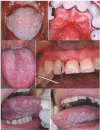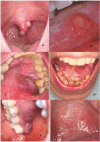Role of the dental surgeon in the early detection of adults with underlying HIV infection/AIDS
- PMID: 22143719
- PMCID: PMC3476100
- DOI: 10.4317/medoral.17527
Role of the dental surgeon in the early detection of adults with underlying HIV infection/AIDS
Abstract
A review is made of the late diagnosis of human immunodeficiency virus (HIV) infection, a subject of growing interest in public health. It has been estimated that in Europe 30% of all HIV-infected people are unaware of their seropositive condition, and this in turn is associated with a poorer long-term disease prognosis and an increased risk of transmission to other individuals. The role of the dental surgeon in this context could be of great importance, since there are many oral lesions that can suggest the existence of underlying infection. The study also addresses the controversial subject of rapid HIV testing, and whether these tests should be performed on a routine basis in the dental clinic, or whether it is preferable to refer the patient to a specialized center.
Figures


Similar articles
-
[Family physician's role in the HIV infection management].An Med Interna. 2007 Aug;24(8):399-403. doi: 10.4321/s0212-71992007000800011. An Med Interna. 2007. PMID: 18020883 Review. Spanish.
-
[The role of the primary care physician in AIDS].Aten Primaria. 1996 Jul-Aug;18(3):103-4. Aten Primaria. 1996. PMID: 8768651 Spanish. No abstract available.
-
The dermatopathologist and human immunodeficiency virus infection.Arch Dermatol. 1989 Nov;125(11):1565-7. Arch Dermatol. 1989. PMID: 2817921 No abstract available.
-
Human immunodeficiency virus: the initial physician-patient encounter.Mayo Clin Proc. 2002 Sep;77(9):957-62; quiz 962-3. doi: 10.4065/77.9.957. Mayo Clin Proc. 2002. PMID: 12233929 Review.
-
HIV/AIDS: An Update for Home Healthcare Clinicians.Home Healthc Now. 2018 Nov/Dec;36(6):348-355. doi: 10.1097/NHH.0000000000000706. Home Healthc Now. 2018. PMID: 30383593 Review.
Cited by
-
Influence of oral biofilm index, caries experience, and laboratory markers of disease progression on the oral carriage of Candida in HIV-infected and non-infected children: a cross-sectional study.Braz J Microbiol. 2022 Dec;53(4):1969-1977. doi: 10.1007/s42770-022-00843-w. Epub 2022 Oct 13. Braz J Microbiol. 2022. PMID: 36224461 Free PMC article.
-
Primary care in dentistry - an untapped potential.J Family Med Prim Care. 2015 Jan-Mar;4(1):13-8. doi: 10.4103/2249-4863.152239. J Family Med Prim Care. 2015. PMID: 25810982 Free PMC article.
-
Dentists as oral physicians: the overlooked primary health care resource.J Prim Prev. 2013 Aug;34(4):279-91. doi: 10.1007/s10935-013-0310-7. J Prim Prev. 2013. PMID: 23728907
References
-
- Pérez-Hoyos S, Ferreros I, del Amo J, Muga R, del Romero, de Olalla PG. Survival and progresión to AIDS in a seroconverter cohorte in the post-highly active antirretroviral therapy era: effectiveness goes on. AIDS. 2006;20:289–91. - PubMed
-
- Gatell JM, Zulaica D, Robledo T, Del Romero J. Como promover y facilitar el diagnóstico precoz de la infección por el VIH-1; Papel de los odontólogos. Cient Dent. 2010;7:65–8.
-
- Hamers FF, Phillips AN. Diagnosed and undiagnosed HIV-infected populations in Europe. HIV Med. 2008;9:6–12. - PubMed
-
- Marks G, Crepaz N, Janssen RS. Estimating sexual transmission of HIV from persons aware and unaware that they are infected with the virus in the USA. AIDS. 2006;20:1447–50. - PubMed
Publication types
MeSH terms
LinkOut - more resources
Full Text Sources
Medical

